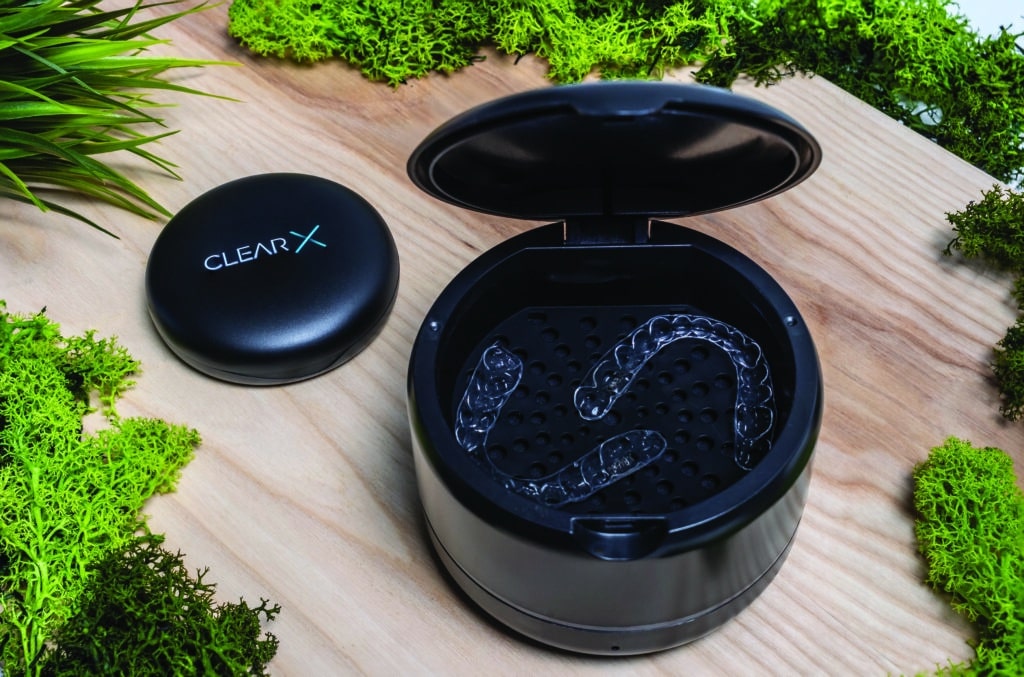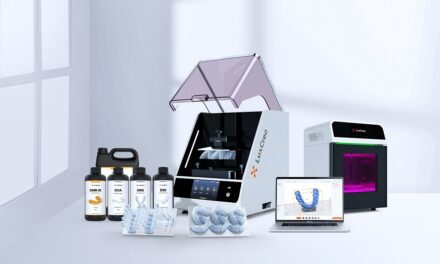Discover how ClearX aligners along with 4D-printing technology are reshaping orthodontic treatment and bringing sustainability into the conversation.
By Alison Werner
It may be time for 3D-printed aligners to pass the baton to a new industry disruptor. K Line Europe is set to launch ClearX aligners, featuring 4D-printing technology, at the upcoming AAO Annual Session in New Orleans.
What is 4D-printing technology?
4D-printed clear aligners combine 3D printing technology and shape memory materials. With this technology, aligner trays are printed using shape memory polymers (SMPs).
SMPs are a type of smart material that can be programmed to change size, shape, and strain over time in response to an external stimulus. More simply, this material can remember its original shape, then be deformed, and when exposed to an external stimulus like heat or light, return to that original shape.1 Researchers are investigating biomedical applications, including medical implants, tissue scaffolds, and medical devices. But it is already finding applications in the orthodontic space.
Application of 4D technology to aligners
Sherif Kandil, DDS, MSc Ortho, CEO and founder of K Line Europe, the manufacturer of ClearX aligners, first heard about 4D technology in connection with NASA research for the Mars Rover expedition. An orthodontist in private practice in Germany at the time, he theorized that the methodology could be applied to orthodontic clear aligners.
“That’s what got me thinking: Why can’t we pre-program the aligner in a certain shape? The material has shape memory. It could actually move from a temporary shape and then turn to a permanent shape,” says Kandil, who launched the first research efforts related to this concept in conjunction with Bonn University and two other universities in 2017. The team set out to evaluate the manufacturing process, the materials, and the patient experience.
What’s the difference between 3D and 4D aligners?
The manufacturing process for standard clear aligners is well-known. Current 3D printing technology allows manufacturers to fabricate aligners by either thermoforming on a 3D-printed model or direct 3D printing. In this case, each aligner is pre-programmed with a specific shape that the teeth are pushed to meet. When it’s time for the next stage of movement, a new aligner with a different pre-programmed shape is introduced. Each aligner is programmed with exactly one shape or movement.
With aligners manufactured with 4D technology, each aligner can have two shapes or stages. When the patient inserts a new aligner, it is similar to a standard clear aligner. The first stage of movement is pre-programmed into the aligner. But when the time comes to move to the next stage, instead of disposing of the aligner and inserting a new one, the patient “boosts” the current aligner to change its shape and uses that same aligner for another stage of movement. The result: one aligner instead of two for two stages of movement, cutting in half the number of aligners and plastic use per case.
Kandil is quick to point out that shape shifting isn’t the differentiator in ClearX, which launched in a pilot phase at IDS in Cologne in March 2023. “Most materials out there have shape memory,” he says. “The differentiator is the shape-shifting characteristic that happens when a stimulus is applied. And to do that, you have to have pre-programming that must happen in the manufacturing cycle.”

What is boosting?
When it comes time for the patient to move into the next stage of teeth movement, they place the ClearX aligner they have been wearing into a small container—ie, the booster—that is packaged with their aligners. They then fill the booster with boiling water to activate the shape-shifting process which takes about 10 minutes. Once done, the patient can put the aligner back in their mouth and wear it for a second stage of teeth movement.
“It’s as simple as that,” says Kandil. “Everyone can do it.”
This non-electric booster comes as part of the ClearX Classic package which the company is launching first in the United States at AAO.
The company also has ClearX Original which features an electric booster. This booster is connected to a mobile app the patient downloads via a QR code on the packaging. The app first notifies the patient that it’s time to boost, then the patient connects the app to the booster via Bluetooth. The electric booster is then activated by the app.
Kandil says the company decided to offer ClearX Classic and the non-electric, non-mobile app dependent booster first to the U.S. market to ensure the system was usable to a wider population. “ClearX Classic makes this experience much easier for so many who are not, let’s say, tech savvy,” he says.
For ClearX Classic the mobile app download is optional. It still offers patients notifications that it’s time to boost, as well as reminders to change to the next aligner, but it doesn’t control the booster itself.
What if the aligner is exposed to another heat source?
Kandil admits he is frequently asked what happens if the aligner is exposed to heat from coffee or tea while drinking. His answer: Nothing.
“That’s why we designed a polymer that is activated or boosted only with very high temperatures—way above what coffee or tea is drinkable at,” he says. In addition, the ClearX Aligner is exposed to that high heat for a prolonged period—10 minutes in boiling water.
The only factor that could lead to a total deformation of the plastic would be leaving it exposed to sun for a prolonged period—but that’s true of any plastic or aligner left in the sun for a long time. And that type of heat doesn’t deform plastic, it destroys it.
Cutting plastics waste in half
Sustainability is at the core of ClearX’s mission. “That was the very first reason why I started this,” says Kandil. This is a process that cuts plastic waste by 50%.
While plastic is a useful material, plastics waste is a global problem. Over 400 million tons of plastic waste is produced every year. And a worrying amount of that is single-use plastic products (like aligners) that are meant to be thrown away after a single short use.2
“If you treat with 40 aligners, give it to me, and I’ll just switch it to 20 ClearX aligners. It’s as simple as that,” says Kandil, adding that the company is aiming to decrease plastic use by 70%.
Kandil envisions widespread use of this technology in the orthodontic industry. He wants to see the whole market collectively decrease plastic waste. And while yes, the environmental impact is a huge driver, the process can also benefit a manufacturer’s bottom line—decreasing materials and operational costs.
The orthodontist’s ClearX experience
When it comes to treatment planning a ClearX case, Kandil says its web-based MotionViewer platform UX offers a similar experience to that of other treatment planning platforms on the market. According to Kandil, where the ClearX treatment planning process differs is in setups.
“The setup size itself is different,” he says. “And what I mean by setup size is the amount of or range of tooth movement per setup is almost double. This goes back to the fact that each aligner is doing the job of two aligners rather than one.”
And when it comes to treatment progression, Kandil says ClearX Aligner treatment duration has shown to be almost 30% less than standard aligner treatment when comparing similar cases and results. And he points to the story of the tortoise and the hare to illustrate why this is happening.
“The 4D aligner is taking small but consistent steps and it’s reactivating itself. It’s not just that it’s shape shifting to the next aligner. It’s reactivating the whole plastic geometry in order to activate the aligner properties, even in areas where the teeth are not pre-programmed to move or change.”
This, he says, translates into higher predictability between every setup and less tooth lag and, accordingly, fewer refinements.
“According to our last data, it was around an 18% refinement rate for a case that starts with ClearX or 4D aligners,” says Kandil.
To date, according to Kandil, ClearX aligners have been used to treat over 3,500 cases worldwide to date, according to Kandil.

Patient engagement with ClearX treatment
Patient compliance with aligner treatment can be a challenge. But as Kandil describes it, the technology and the sustainability commitment underpinning ClearX aligners can engage patients in new ways.
“This is something that is totally different [the technology and the sustainability element]. This is something that has a meaning and a very bold mission behind it. [Patients] feel they are a part of something,” he says.
Kandil sees the boosting step as an opportunity for the patient to engage with their treatment in a direct way. No longer are they passively taking one aligner out and putting the new one in. Here they can use cutting-edge technology in their own home and experience a little bit of magic.
Patients always wonder if it is going to work, says Kandil. But then, when they insert it in their mouth, they feel how it has changed shape. It feels like a new aligner.
The ClearX system comes packaged in eco-friendly materials and includes a message about the company’s mission and how the patient is now part of that. As Kandil describes it, the message is: You’re not only aligning your teeth, but you’re helping the planet, and you’re helping the whole market move in the direction of sustainability.
And that feeling of being part of something can translate into an effective marketing campaign to differentiate the practice from other local practices that are all marketing the fact that they use the same leading aligner brands.
Private label services
Kandil’s fascination with and belief in clear aligners as an effective treatment modality led him to found K Line Europe in 2014 in Germany. The clear aligner manufacturer entered the market in 2016 and 2 years later, more than 2,000 doctors were using K Clear Aligners. Skip ahead to 2020 and the company entered the private label market. By 2021 it was one of the largest private label providers in Europe and had produced over 2 million clear aligners for its clients.
In 2022, K Line received FDA approval and entered the U.S. clear aligner market. More recently it opened a fulfillment center in Dallas and by the end of the year it expects to begin manufacturing in the US.
Like its evolution in the European market, the company has initially focused on its OEM services in the US. Today the company provides private label services to orthodontic labs, DSOs, and individual orthodontic practices, offering manufacturing, shipping, and logistics, as well as marketing and branding support.
K Line’s OEM services will remain the core of its business, according to Kandil, but his goal is to see the use of 4D technology spread throughout the orthodontic industry—and the AAO Annual Session is the first step in raising awareness about the technology and its ability to change orthodontics.
“AAO represents a very important milestone for us,” he says.
According to Kandil, K Line will eventually make ClearX aligners a part of its OEM services and envisions the potential of licensing their manufacturing process. In fact, he considers it a moral obligation. “I’m a very firm believer that this technology shouldn’t be just in the hands of only one [manufacturer]. It must spread to many manufacturers.” OP
Alison Werner is the chief editor of Orthodontic Products.
References
- British Plastics Federation, Shape Memory Polymer – A Complete Guide, https://www.bpf.co.uk/plastipedia/applications/shape-memory-polymer.aspx Accessed 3/26/2024.
- UN Environment Programme, https://www.unep.org/interactives/beat-plastic-pollution/#:~:text=Around%20the%20world%2C%20one%20million,once%20and%20then%20thrown%20away Accessed 3/26/2024.










